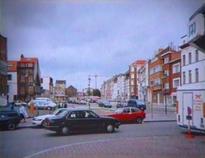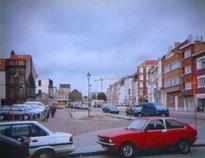PHILIPPE VAN DAMME
Philippe Van Damme’s main preoccupation seems to be the city, its construction and the notion of time reflected in it. In Rue de l’Avenir he zooms in on a hundred year old demolished street in Brussels. For Der Landmesser am Japanischen Palais he went to Dresden and discovered (what did you expect?) a completely different city. After having completed Rue de l’Avenir Van Damme wanted to make something different: shorter and sharper. Something reflecting – in a clearer way – the idea of a street as the illusion of movement in space and time.
Van Damme doesn’t work with a video- or film- camera: he developed his own animation technique allowing him to work with static photographic images. For Rue de l’Avenir he made 45 photographs, going along the street with his camera, which after being edited gives the idea of a travelling movement, going up and down the street, zooming in and out.
For Der Landmesser am Japanischen Palais he made 48 pictures putting his recyclable Japanese camera in each of the holes of the rotunda standing in front of the Japanese Palais in Dresden. His archaic film-technique (reminiscent of Méliès’ special effects) in combination with the speed of the editing (reflecting contemporary hectic TV-culture) situates his work in a no-man’s-lands where time is no longer in charge.
Just as in Rue de l’Avenir Van Damme takes us in Der Landmesser am Japanischen Palais on a travel in time. But this time the journey takes us back 600 years. In contrast with the aggressive in and out movement of Rue de l’Avenir, this video has a nucleus structure. Unlike the ‘lasagna structure’ of Brussels, where different layers of the city are built one upon the other, Dresden has a centric structure. To Van Damme, Dresden is the city where time stood still. Everything that once disappeared came back: after the destruction during the second World War, a new city was built according to its old constructions. Van Damme not only uses his own pictures to give us the impression of time, but also uses old drawings showing the same city in different times.
Talking about his cityscapes, Philippe Van Damme likes to refer to the life and work of the Italian renaissance painter Canalletto, who made legendary perspective studies in Venice, but who was also one of those early real Europeans, travelling through the major European capitals. Like Canalletto’s, Van Damme’s work are studies. Trying to imagine his own city (Brussels) but also working as an outsider, showing a new perspective on a formerly unknown city. In Der Landmesser am Japansichen Palais, Philippe is like the foreign painter: looking from the west towards the east. Looking at the city of Dresden as a rotunda between east and west. Dresden as a symbol for European culture (with completely different accents as Brussels). Like the rotunda on top of the tower of Babel, where the Japanese temple stands brotherly next to the Eastern one. A mixture of temples, like the mixture of languages one can find in Europe. Dresden as a sign that one can easily change from one ‘culture’ to the other. The Japanese Palais is still the same one, even if it was called the Dutch Palais in another period…
After all, the city of Dresden and the surroundings of the Japanese Palais haven’t changed a lot, while the surroundings used in Rue de l’Avenir have changed completely over the last twenty years. (Source: Pieter Van Bogaert)


- ° 1965 Brussels (Belgium).
-
EVENEMENTEN
-
At view in the media library
WERKEN